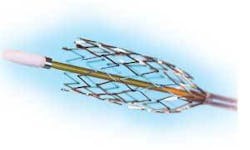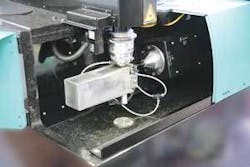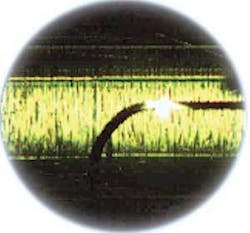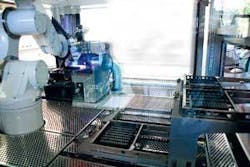Cutting intricate microstructures
New generation laser boosts productivity and quality in stent manufacturing
Stent manufacturing processes currently involve few automated operations and lack closed-loop process control procedures. New stent generations call for more uniform characteristics and thus for a significantly higher degree of process control. A key element for achieving these aims is a new diode-pumped fiber laser cutting system excelling by speed, accuracy, and an outstanding level of process control capability.
“The emergence of new generations of stents creates the need for an in-depth redesign of the manufacturing process chain as a whole,” reveals Dr.-Eng. Michael Giese, CEO of eucatech AG (Rheinfelden, Germany), an innovative manufacturer of medical technology for interventional cardiology and radiology with a specific focus on stent systems and related application equipment. Stents are expandable metal grid structures used to stabilize weakened blood vessels, for example after removal of clogging coagulations. Standard procedure for their application is the introduction using a specialized catheter and a subsequent expansion by a ballooning tip section. Alternative technologies using memory effect alloys have become available as well. Stents are produced from thin-walled tubes made of high-quality metal alloys such as stainless steel, cobalt chromium alloys, or memory effect alloys such as Nitinol. The filigree, intricate grid structures that are the prerequisite for achieving their impressive diameter expansion ratios, are produced using precision laser cutting technology. With the challenges resulting from new developments, manufacturers have to focus on the stability and uniformity of cutting process results.
Objective: total quality management
“As any foreign material inserted into the body, a stent will interact with its environment, creating an irritation that might interfere with the healing process,” discloses Giese. New developments thus include stents with drug-eluting coatings consisting of a biodegradable matrix releasing suited drugs such as Paclitaxel over a period of 8 to 10 weeks after insertion. But this improvement also generates higher requirements to be met by manufacturing processes as this automatically implies additional validations and approvals by bodies such as the US Food and Drug Administration (FDA). In order to ensure appropriate drug dosing, the latter prescribes a very restricted scatter bandwidth for the total surface area of the stent, thus significantly narrowing manufacturing allowances from formerly some 15 percent to a mere 6 to 8 percent. Together with the trend to further reduce strut dimensions from about 110 µm down to merely 60-85 µm, these requirements exceeded the accuracy limits of the laser cutting systems the company had previously used. Furthermore, it became obvious that together with the shift to an enhanced laser technology offering higher precision, the whole process chain layout would have to be reassessed. In the long term, the current semi-industrial approach involving multiple manual operations and open loop, batch-oriented quality assurance procedures will have to be replaced by a monolithic, IT-based total quality management system involving fully automated and controlled process chains “from tube to stent” without any manual interference.
“The laser cutting process marks the very start of the whole process chain-and is at the same time crucial for its ultimate result,” adds Eduard Fassbind, CEO of swisstec AG (Schaan and Zürich, Switzerland), a company that has specialized in the manufacture of high-precision laser micromachining systems as customized turnkey solutions. The plant selected was the micro-T15F, a specialized tube cutting system equipped with a diode-pumped redPower fiber laser source from SPI (Southampton, UK) with a power rating of 50 or 100 watts. The unit has been carefully tailored to fulfill all requirements for the high-precision production of stents on an industrial scale. All components, starting from the sturdy granite base structure, the linear drive x-axis and the proven laser forming/focusing system right through to the state-of-the art IT control system are designed for virtually maintenance-free 24/7 production service. The control system includes a CCD camera monitoring system for the laser beam focus on the workpiece. The plant excels due to its very narrow laser focus of just 10-12 µm and an outstanding cutting speed of currently 500-600 mm/min as compared to the 150-250 mm/min achieved by its predecessor. Tests conducted jointly with a customer have already revealed that with additional internal water cooling of the tube, cutting speeds of up to 2000 mm/min are attainable.
“Among the features we welcome most with the new plant is the transition from lamp pumping to diode pumping technology,” says Giese. The main problem with the lamps was the fact that, apart from their rather limited service life of some 2000 hours, their drift influenced the characteristics of the laser beam resulting in unstable processing parameters. All too often the result was batches with substandard or even out-of-tolerance products after only a few hundred hours of service. Production then had to be halted and could only be resumed after the laser system had been thoroughly readjusted, a task that could easily take more than a full shift’s time span and required the involvement of highly qualified-and thus so paid-specialists.
In stark contrast to this situation, the characteristics of the new diode-pumped lasers can quite easily be adjusted by normal workforce and remain stable over very long time periods, resulting in reproducible processing results. Downtimes have been halved, machine usability has jumped to well above 90 percent, and the share of out-of-tolerance products has dropped significantly. On top of this comes the superior processing speed of the new system producing stents at twice the rate achieved by the older workstations. The overall result is a very substantial rise in the output of marketable products per unit and day.
“The new laser cutting system is just the first building block having to interface to further inspection and treatment plants that will ultimately form a complete automated production chain,” explains Giese. Another key component is a fully automated optical inspection station that is capable of performing an unmanned 100 percent optical quality assessment of the inside and outside geometry of stents with a resolution of just 1 µm. This unit is used twice, first for an assessment of the stent geometry immediately after laser cutting and in a second and more thorough round after the stent has passed further production steps such as electro-polishing and heat treatment.
This inspection provides for a fast-reacting quality control feedback to the laser cutting unit enabling it to continually optimize production parameters while, on the other hand, it becomes possible to adapt certain parameters of the electro-polishing process to geometrical peculiarities of the current production. During its second pass through the optical inspection unit, a full assessment of the surface quality of the stent is performed in addition to a check for correct form and geometry. The control system will then compare the results to a knowledge base of all defect types previously logged by the company.
Partnership for innovation
“The third building block we have already put to operation is a high vacuum heat treatment unit,” says Giese. This process step is vital to ensure the desired combination of mechanical properties of the stent material, which has to feature high plasticity in combination with mechanical strength, defined expansion characteristics and, above all, absolute reliability with respect to breakage.
Together with the laser cutting unit and the optical inspection plant, eucatech already operates three of the decisive plant types of its future fully automated stent production chain. Their current arrangement in a common lab already outlines their relative positions in the projected production line, to be complemented later by further plants as well as by robot handling and conveying systems.
Of course, realizing such a far-reaching vision is not an easy task and the way is paved with numerous unexpected difficulties. Under such circumstances, supplying a good plant simply is not enough: all parties involved are called to team up in an ongoing innovation process. “This aspect has played a key role when we selected Swiss Tec as the supplier for our laser equipment,” reveals Giese, adding that “this decision was founded on mutual confidence resulting from the experience of six years of close cooperation.”
Klaus Vollrath ([email protected]) is a technical journalist based in Switzerland.






